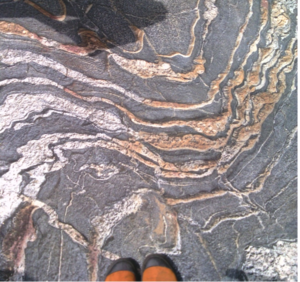Difference between revisions of "Syncline"
Cwhitehurst (talk | contribs) |
Cwhitehurst (talk | contribs) |
||
| (9 intermediate revisions by the same user not shown) | |||
| Line 1: | Line 1: | ||
| − | + | {{Wiki Write Off Entry | |
| + | |image=AAPG-WIKI-Write-off.jpg | ||
| + | |student chapter=University of Ilorin | ||
| + | |competition=June 2015 | ||
| + | }} | ||
| + | A syncline is the downward arc or curve of a [[fold]]. A fold, in geology, is a bend in a rock layer caused by forces within the [[crust]] of the earth. The forces that cause folds range from slight differences in pressure in the earth’s crust, to large collisions of the crust’s [[tectonic plate]]s. These tectonic forces are usually compressions within the earth crust and vary in magnitude and intensity from place to place, producing a wave-like or undulating pattern or structure. These varying compressing forces equally result in differences in size of folds, that is, some folds may be a few centimeters thick while some several meters or more like the syncline at the Canadian Arctic on Ellesmere Island. If “undisturbed” by events such as tilting or faulting, among others, a fold should have its crown or crest as the [[anticline]] and the trough of its structures as the syncline. The anticlinal and synclinal features of a fold usually go hand in hand, and the nature of their shape, position and occurrences determines their name designated to each fold structure. Folds are easily seen after being exposed by erosion. | ||
| − | + | [[File:UI_Synclines_Fig_1.png|thumb|300px|{{figure number|1}}A diagram showing the structure of a fold (Courtesy Wikipedia)]] | |
| − | |||
| − | |||
| − | |||
With all the above explained, a syncline may now be described as a part of a fold which has the youngest bed of the strata in its core or center of the structure which has been folded. This is the best term used to describe it rather than “downward arc or trough of a fold” this is because due to events when strata has been overturned, a syncline could arch upwards, this type of synclines are called “antiformal synclines”. So in order words, a syncline is identified by the younger rocks at it’s core. In folds, crests and troughs are usually firstly referred to as synforms and antiforms until the age of the rocks are known. | With all the above explained, a syncline may now be described as a part of a fold which has the youngest bed of the strata in its core or center of the structure which has been folded. This is the best term used to describe it rather than “downward arc or trough of a fold” this is because due to events when strata has been overturned, a syncline could arch upwards, this type of synclines are called “antiformal synclines”. So in order words, a syncline is identified by the younger rocks at it’s core. In folds, crests and troughs are usually firstly referred to as synforms and antiforms until the age of the rocks are known. | ||
| − | [[ | + | [[File:UI_Synclines_Fig_2.png|thumb|300px|{{figure number|2}}A fold showing anticlines and synclines at an outcrop at Eruku, Kwara, Nigeria.]] |
==Synclines and the environment== | ==Synclines and the environment== | ||
Synclines may affect the environment in two simple ways: | Synclines may affect the environment in two simple ways: | ||
| − | # Topography: | + | # Topography: Synclines existing at young landscapes affect the topography but at long existing or older landscape, they have no necessary effect. |
| − | # Landforms: | + | # Landforms: Synclines do not basically create landforms but for a few exceptions. If the rocks occupying the center of the syncline are soft, the effect of erosion on them will bring about a valley and if the core occupying rocks are hard,erosion,when it occurs will carve them into a peak. |
==Economic importance== | ==Economic importance== | ||
| − | Synclines aid in collecting | + | Synclines aid in collecting and storing underground water, thereby forming aquifers or groundwater basins. |
==References== | ==References== | ||
| − | # | + | # [http://geology.about.com/library/bl/images/blsyncline.htm A structural overview of synclines] |
# [http://www.geonami.com/structural-geology/ Structural Geology; anticlines and synclines] | # [http://www.geonami.com/structural-geology/ Structural Geology; anticlines and synclines] | ||
# [http://www.eoearth.org/view/article/152808/ Folding and faulting in the earth's crust] | # [http://www.eoearth.org/view/article/152808/ Folding and faulting in the earth's crust] | ||
Latest revision as of 15:58, 21 March 2019
| Wiki Write-Off Entry | |
|---|---|

| |
| Student Chapter | University of Ilorin |
| Competition | June 2015 |
A syncline is the downward arc or curve of a fold. A fold, in geology, is a bend in a rock layer caused by forces within the crust of the earth. The forces that cause folds range from slight differences in pressure in the earth’s crust, to large collisions of the crust’s tectonic plates. These tectonic forces are usually compressions within the earth crust and vary in magnitude and intensity from place to place, producing a wave-like or undulating pattern or structure. These varying compressing forces equally result in differences in size of folds, that is, some folds may be a few centimeters thick while some several meters or more like the syncline at the Canadian Arctic on Ellesmere Island. If “undisturbed” by events such as tilting or faulting, among others, a fold should have its crown or crest as the anticline and the trough of its structures as the syncline. The anticlinal and synclinal features of a fold usually go hand in hand, and the nature of their shape, position and occurrences determines their name designated to each fold structure. Folds are easily seen after being exposed by erosion.
With all the above explained, a syncline may now be described as a part of a fold which has the youngest bed of the strata in its core or center of the structure which has been folded. This is the best term used to describe it rather than “downward arc or trough of a fold” this is because due to events when strata has been overturned, a syncline could arch upwards, this type of synclines are called “antiformal synclines”. So in order words, a syncline is identified by the younger rocks at it’s core. In folds, crests and troughs are usually firstly referred to as synforms and antiforms until the age of the rocks are known.
Synclines and the environment
Synclines may affect the environment in two simple ways:
- Topography: Synclines existing at young landscapes affect the topography but at long existing or older landscape, they have no necessary effect.
- Landforms: Synclines do not basically create landforms but for a few exceptions. If the rocks occupying the center of the syncline are soft, the effect of erosion on them will bring about a valley and if the core occupying rocks are hard,erosion,when it occurs will carve them into a peak.
Economic importance
Synclines aid in collecting and storing underground water, thereby forming aquifers or groundwater basins.

